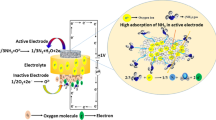Abstract
In electrochemical CO2 gas sensor, the chemical potential of electrolyte changes on adsorption of CO2 molecules as the process involves catalytic electron transfer. In addition, it is the rate-determining step that decides sensor’s response. In this study, in-situ bulk AC, DC and surface electronic conductivities of CaCO3 + Li2CO3 binary solid electrolyte were investigated at different temperatures and CO2 gas partial pressures using complex impedance spectroscopy, Wagner’s DC polarization technique and four-probe method, respectively. For the four-probe conductivity measurements with crucial requirement of high temperatures and test gas variations, a customized sample holder was designed and fabricated having gold-plated equidistant, spring-loaded electrodes and localized heating system (maximum 593 K). The AC bulk conductivity was found to decrease with rise in CO2 gas concentration (from 0.1 to 100%) by about two orders and one order of magnitudes at lower and higher temperatures, respectively. Similarly, surface conductivity variation with temperature also showed Arrhenius behaviour for both the concentrations of CO2 viz. 0.04 and 10%, giving lower value of activation enthalpy for lower CO2 concentration. The surface conductivity change in the presence of different concentrations of CO2 gas is justified by comparing with AC bulk conductivity measurements at different CO2 partial pressures and DC conductivity along with sensing response. The mechanism is explained using activated charge transfer data. The range of Ea values on adsorption of CO2 gas was found to be in the electronic excitation window, suggesting involvement of a new parameter to be investigated for non-Nernstian response of EC sensors.









Similar content being viewed by others
References
Chandra S 1981 Super ionic solids: principles and applications (Amsterdam, North-Holland: Elsevier Science Ltd.) ISBN-13: 978-0444860392
Ambekar P, Randhawa J and Singh K 2014 Adv. Sci. Lett. 20 565
Janata J and Huber R J (eds) 1985 Solid state chemical sensors (Orlando: Academic Press Inc.) ISBN: 0-12-380210-5
Dietz J H 1982 Solid State Ion 6 175
Josowicz M and Janata J 1988 Solid State Ion 28 1625
Weppner W 1986 Proc. 2nd Int. meeting on chemical sensors Bordeaux, France p 59
Singh K, Ambekar P and Bhoga S S 2002 in Solid state ionics: trends in new millennium B V R Chowdhari et al (eds) (Singapore: World Scientific Publishing Co.) p 469
Haynes W M 2010-11 in CRC handbook of chemistry and physics David R Lide and William M Haynes (eds) (Taylor & Francis) p 91
Smits F M 1958 Bell Syst. Tech. J. 37 711
Scherrer P 1918 Gottinger Nachrichten Gecell. 2 98
Barin I 1993 Thermochemical data of pure substances 2nd edn (Weinheim: VCH) vol 1 and 2
Starecki F, Charpentier F, Doualan J-L, Quetel L, Michel K, Chahal R et al 2015 Sensor Actuat. B Chem. 207 518
Xiong Y, Xue Q, Ling C, Lu W, Ding D, Zhu L et al 2017 Sensor Actuat. B Chem. 241 725
Ersöz B, Schmitt K and Wöllenstein J 2020 Sensor Actuat. B Chem. 317 128201
Huang X J, Aldous L, O’Mahony A M, Campo F J D and Compton R G 2010 Anal. Chem. 82 5238
Rezk M Y, Sharma J and Gartia M R 2020 Nanomaterials 10 2251
Nafe H, R Waser, S Hoffmann, D Bonnenberg and Ch. Hoffmann (eds) 1994 Electroceramics IV (Germany: University of Technology) (vol II) p 745
Randhawa J B, Ambekar P, Singh K and Bhoga S S 2004 Ionics 10 45
Hariharan K and Maier J 1995 J. Electrochem. Soc. 142 3469
https://www.vaisala.com/sites/default/files/documents/GMW80-Series-Datasheet-B211435EN.pdf
https://www.electronicscomp.com/gas-sensor/mg811-air-carbon-dioxide-co2-sensor-module
Hunter G W and Xu J C 2008 US Patent nos. 8,702,962 and 8,052,854, https://technology.nasa.gov/patent/LEW-TOPS-59
Acknowledgement
UGC Western Regional Office, Pune, is greatly acknowledged for financial support in carry out this work.
Author information
Authors and Affiliations
Corresponding author
Rights and permissions
About this article
Cite this article
Ambekar, P., Randhawa, J. Surface conductivity of binary carbonate as a performance-governing parameter of an electrochemical CO2 gas sensor. Bull Mater Sci 44, 235 (2021). https://doi.org/10.1007/s12034-021-02526-y
Received:
Accepted:
Published:
DOI: https://doi.org/10.1007/s12034-021-02526-y




